The Google Nexus 7 Review
by Anand Lal Shimpi & Brian Klug on July 26, 2012 11:35 AM ESTThe Display
In this new age of high resolution panels with small dimensions, the goal seems to be to just get the display out of the way. You shouldn't notice the display, it should just quietly do its job and make you believe that what you're looking at is real. When viewed with this critical eye, very few displays do their job well.
The Nexus 7's display is somewhere between good and perfection. It's not on the latter end of the spectrum, but it's great for $199. Black levels are good, and max brightness is more than enough for indoor use, although you'll have problems outdoors if it's too sunny.
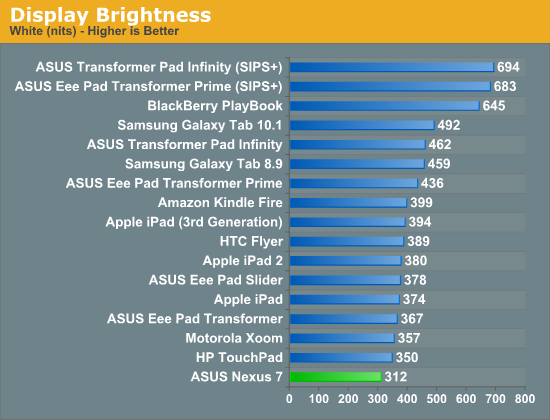
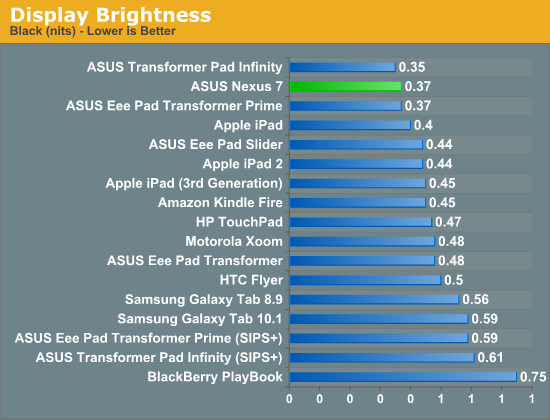

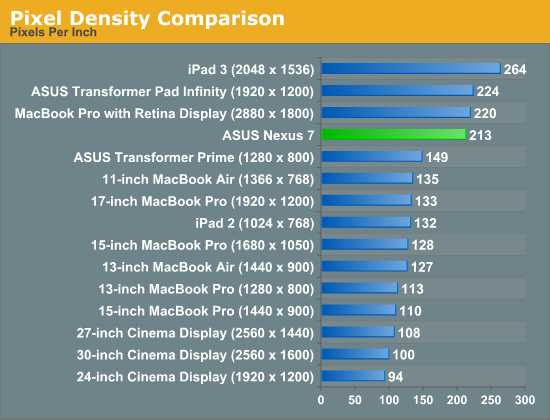
The resolution is high enough that neither Brian nor I were able to identify individual pixels at our normal viewing distances. Images do look better on the new iPad however (not a resolution but rather a panel advantage).
The other interesting aspect of the Nexus 7 is that it is a relatively new and somewhat interesting display form factor. 213 pixels per inch in a 7 inch display is unique for an Android tablet, and puts the Nexus 7 in the "tvdpi" screen density category for Android, 600 x 961 dp (that's dp - density independent pixels, relative to 160 ppi).
The end result is that some applications get a scaled down version of the 10" form factor Android 4.x UI, others don't. Some pages use the phone layout (for example the settings page, play store, and the notifications shade), others use the tablet two pane layout (for example Gmail) due to the 600dp width of the Nexus 7. That is to say it isn't totally correct to say that the UI on the Nexus 7 is a larger, scaled version of the phone UI, but something of an intermediary between the traditional 10" tablet version, and the phone version depending on what the break point is (in dps) for the particular app.
The other interesting note is that because 'tvdpi' isn't a primary display density for Android developers to build assets against, most often bitmaps get scaled down from the hdpi asset. In most places there isn't much of a noticeable softening of the edges, but I'll admit there are a few places where it's obvious bitmaps have been decimated and look a bit soft. Luckily, the pixel density of the display itself is high enough to mask most of this, but it isn't always perfect.
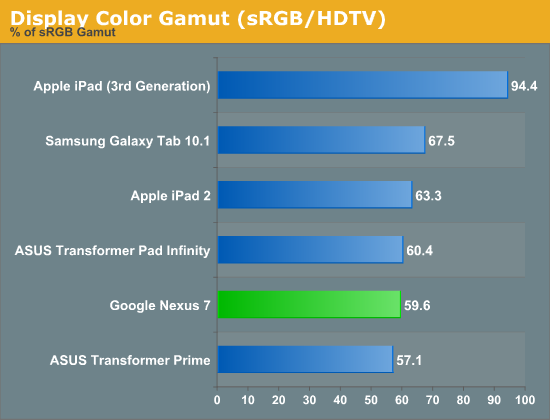
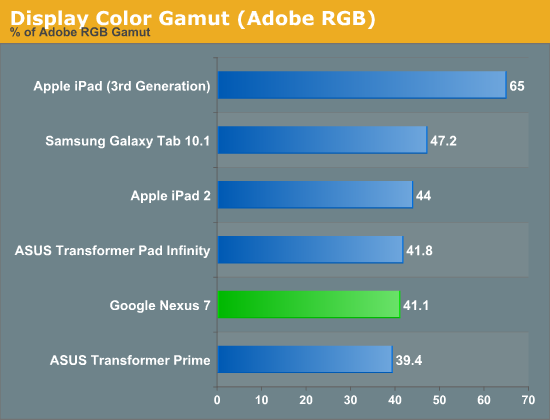
The Nexus 7's IPS panel offers great viewing angles, something that's simply a requirement for any device whose primary interface revolves around the display. Color accuracy is simply middle of the road, but I don't expect many users to do a lot of professional photo editing on the Nexus 7 so I'm not sure how much this actually matters.


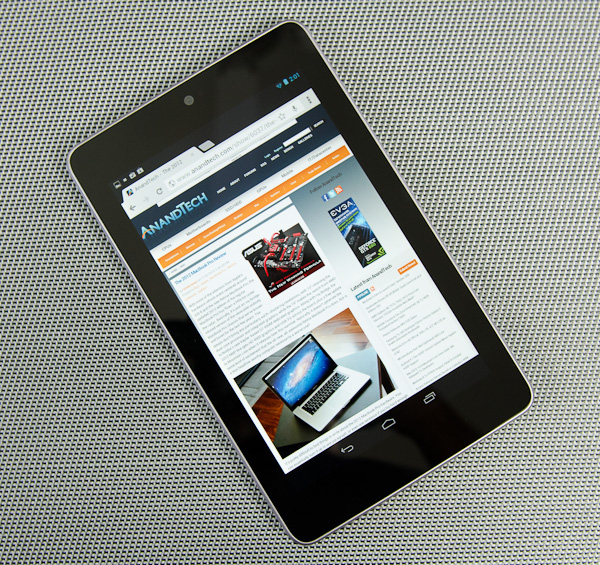








118 Comments
View All Comments
Sined - Thursday, July 26, 2012 - link
Hey Anand, great review as usual.I want to point out something about the lack of an SDcard slot.
Dan Morrill from Google Android team explained on Reddit why Google is moving away from SDCard storage on Nexus Devices.
It's a really interesting read on the reasons why.
http://www.androidpolice.com/2011/11/18/impromptu-...
Lucian Armasu - Thursday, July 26, 2012 - link
You keep putting Windows RT together with Windows 8, as if they are the same thing and will be just as successful (or will fail just as much). But in what way is a Windows RT tablet, especially one that is twice as expensive, or at least as expensive as an iPad, better than an Android tablet? Is there an advantage at all that they hold over Android tablets? Because I see none, and I'm not sure why you keep up-playing Windows RT while downplaying Android tablet throughout your article.antef - Thursday, July 26, 2012 - link
Agreed....a hybrid x86 Win8 device might appeal to some people, but a WinRT ARM tablet is not inherently better than Android. I would actually argue Android is better because its app ecosystem is more mature and all the Google services apps are a given. Metro is completely unproven.WinRT will have the limited desktop with a simplified set of Office apps, that's it. I don't care about that at all, along with many other people I'm sure.
Impulses - Friday, July 27, 2012 - link
Office RT is the only clear advantage out of the gate, if they actually provide a featured desktop conversion that just happens to run on ARM... If all they put out is a Metro stepchild then that goes out the window. (no pun intended) It's a big selling point tho, but only if Win RT tablets are price competitive with iPads and Android tablets.Personally I'm still not sold on this holy grail of device convergence either way. 12" or smaller laptops are too cramped for serious work, and tablets just aren't as comfortable for use around the house at that size either. 7" or 8.9" is ideal IMO, specially as an addition to a 13"-14" laptop which is probably the most common scenario.
I say that despite having enjoyed using a 10" ASUS Transformer for over a year now. Currently I have that and a 3 year old netbook and I'm really yearning for a larger laptop replacement for the latter and a smaller tablet in the long run (the TF + dock has been a nice replacement for the netbook when traveling without work duties tho).
EnzoFX - Thursday, July 26, 2012 - link
Why will Win8 Tablets cannibalize Android tablets?I'm all for more competition, and MS is definitely bringing it, but are you implying it'll overtake Android right away? MS has a long way to go before that. Even their specs seems underpar, except for the intel powered one, which comes in at ultrabook pricing...
Impulses - Friday, July 27, 2012 - link
If that... I seriously don't see how Intel powered tablet hybrids will come in at ultrabook pricing all the while sporting better displays and near identical hardware all around (with a more complex builds). Something's gotta give, or the build quality of ultrabooks has inflated prices a ton...TareX - Friday, August 3, 2012 - link
Windows 8 RT is DOA. No apps, no way to compete, and it's too late in the game to start a new third party base. Windows 8 pro tablets are GREAT, except that they won't be price anywhere close to being competitive, so those are kind of DOA too in a different way. Very few people would pay $800-1000 for a tablet.Death666Angel - Thursday, July 26, 2012 - link
Thanks for the video review, I started missing them already! :DIf the Nexus had an SD slot and more storage out of the box without a 50USD increase in cost, I'd probably already have one. As it stands now, I'm content with my Chinese tablet (Cube U30GT). It has issues, but for the price (260€) it is pretty great. And I'm 100% with you, paying too much for tablets right now is not a smart move, considering the rapidity of the hardware development.
TareX - Friday, August 3, 2012 - link
You do realize this pricing is actually super generous on Google's behalf (they're selling it at a loss), yet you want them to include a MicroSD, and have more storage without the $50 bump. I'm all for a MicroSD but you're getting a wee bit too greedy here. There's a reason it's out of stock almost everywhere.Mr. Context - Thursday, July 26, 2012 - link
Hey, I think the biggest differences between the devices is in their aspect ratio and he HDMI output. Please check this link to hear my 50 cents on it... http://bit.ly/OezNK7